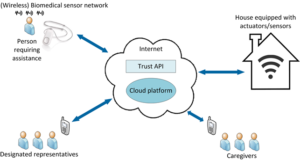Trust and trustworthiness are the basis for taking decisions, certainly in a care setting involving vulnerable individuals. Within the scope of assisted living and community care, decisions entail, for example, sharing – often sensitive – personal data, providing access to devices or premises and contacting care professionals or family members. In case these decisions need to be taken – or at least supported – automatically by electronic devices, a basis of trust needs to be established electronically, as part of the system operation. The example use case that is addressed within the health domain concerns a frail person (the ‘resident’), potentially subjected to an accident, where the system needs to decide to select and delegate decision powers to a trustable person (the ‘responder’) in a secure way. To that end, the system needs to monitor the resident, but also its own operation, and balance risk with a subjective notion of trust which can be aided by information and computation coming from cloud resources.
This overarching challenge will be addressed through pursuing the following objectives:
A top-level system diagram highlighting the main actors is shown in figure:

